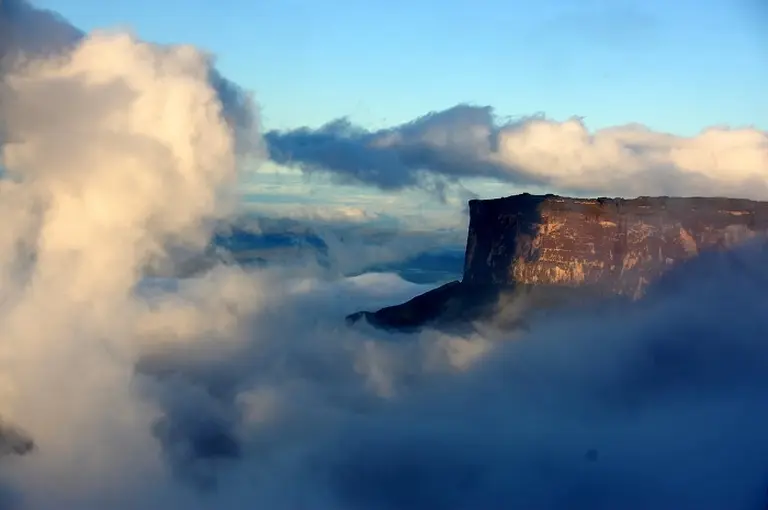Over the years, Mount Roraima has gained popularity among adventurous tourists. Visitors can trek across the vast Gran Sabana plains to reach the mountain, often in guided groups led by locals. For those seeking a quicker route, helicopter rides to the summit are also available.
“An Island Above the Clouds” in Venezuela
Roraima Mountain is a mesmerizing destination for nature lovers seeking a glimpse of surreal landscapes. Often described as an “island above the clouds,” this flat-topped mountain is one of the oldest geological formations in the world, dating back over two billion years. It is a part of the ancient Guiana Shield and was formed between 250 and 400 million years ago due to magma forcing its way through limestone, followed by erosion from wind and rain that sculpted its current striking features.

Straddling the borders of Venezuela, Brazil, and Guyana, Mount Roraima is located within Venezuela’s Canaima National Park. Its summit rises to 2,810 meters (9,219 feet) above sea level, with a flat plateau spanning 30 square kilometers (12 square miles) at an elevation of 2,338 meters (7,670 feet). Surrounded by mist and clouds, the mountain exudes an ethereal and mysterious charm.
Known by various names such as Tepuy Roraima and Cerro Roraima, the mountain’s distinct tabletop is composed of sheer sandstone cliffs that rise 400 meters (1,312 feet) from the ground. In the Pemon language, the indigenous people call it “tepui,” which means “house of the gods.” This mythical reputation has made Roraima a source of inspiration for legends and works of literature, including Arthur Conan Doyle’s The Lost World.
Mount Roraima – Known as “The Lost World”
Mount Roraima is a striking, flat-topped mountain nestled within the vast Gran Sabana plains of South America. It belongs to the Pakaraima Mountain Range and is considered one of the most unique geological wonders in the world.

This tepui, or tabletop mountain, is shared by Venezuela, Brazil, and Guyana. In the indigenous Pemon language, tepuis are referred to as “houses of the gods.” Roraima’s summit rises to 2,810 meters (9,219 feet) above sea level, making it one of the highest tepuis in the region. Trekking to the top involves a two- to three-day journey from Venezuela through challenging terrains. Upon reaching the summit, hikers are greeted with surreal landscapes and the Triple Border Point, where the three countries meet.
The unique weather conditions on Roraima contribute to daily rainfall, which carves streams and waterfalls that cascade from the summit’s cliffs. These waterfalls create a breathtaking visual spectacle while also sustaining the region’s isolated ecosystem.
A Prehistoric Paradise
The summit of Mount Roraima is like a prehistoric island, harboring flora and fauna that have evolved in isolation for millions of years. Approximately 35% of its plant species, including carnivorous plants like the Marsh Pitcher Plant, are endemic to the mountain. These plants have developed fascinating adaptations, such as trapping insects in tubular leaves to digest them for nutrients.

The mountain’s sandstone plateau is dotted with strange rock formations, caves, and pools carved by erosion, evoking a primeval landscape. Geologically, Roraima dates back to the Proterozoic Eon, with sandstone layers resting atop igneous rock, shaped over millennia by natural forces.
Cultural and Literary Influence
Mount Roraima has inspired numerous myths, legends, and creative works. For the indigenous people, it is a sacred place intertwined with spiritual beliefs. In modern culture, it inspired Arthur Conan Doyle’s The Lost World (1912), a novel exploring prehistoric creatures on an isolated plateau. More recently, Roraima’s dramatic landscapes influenced the floating Paradise Falls in Pixar’s animated film Up.

For visitors, Roraima offers a sense of detachment from the modern world. Although the journey is arduous, its ancient beauty, surreal ecosystems, and the chance to witness a “lost world” make it an unforgettable experience.
Summary:
Mount Roraima is a geological and ecological marvel, with its ancient flat-topped structure, unique biodiversity, and cultural significance. It stands as both a natural wonder and a testament to the incredible forces that have shaped our planet. Whether viewed as the inspiration for legendary tales or as a sacred site for indigenous people, Roraima continues to capture the imagination of explorers and dreamers alike.


